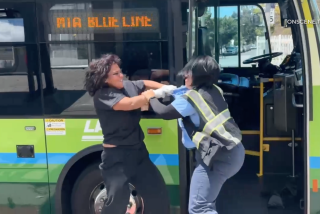Sure beats walking or biking, O.C. bus riders say
After nine days of walking, biking and begging for rides, nannies, maids and laborers boarded the Route 57 bus at dawn Wednesday, ecstatic for a ride from Orange County’s working-class neighborhoods to its tony coastline.
Of all the routes that vaporized during the Orange County bus drivers’ strike, one of the most missed was Route 57, the line that delivers the workforce that keeps places such as Newport Beach humming.
The commuters were among the casualties of the strike that ended this week: Some lost hundreds of dollars because they paid hefty sums to illegal cabbies, or simply could not get to work.
Teresa Flores, 27, of Santa Ana said the strike’s end was “a weight lifted off my shoulders. I was biking to work, and it was too hard. I was spending three hours a day on a bike.”
Several commuters said they were shocked when the buses stop running, leaving many working poor stranded.
“I couldn’t believe it,” said Juan Fares, 59, a Santa Ana painter who two years ago sold his car because he could not afford the gas, insurance and repairs on his $300 weekly salary.
“It would be like closing a hospital down. You just don’t do that.”
Of the county’s 435 buses, 421 were operating Wednesday morning, although ridership was light because some commuters were unaware that service had been restored. By Friday all routes will reopen, Orange County Transportation Authority officials said.
On Monday, drivers agreed to a contract that contained pay raises from 10.8% to 11.7%, depending on seniority, over three years.
OCTA spokesman Joel Zlotnik said that “no fare increases are planned because of this contract.”
But for the riders aboard the 57, which broke the silence of dawn as it whooshed down Bristol Street in Santa Ana, talk centered around worry that fares might increase because of the drivers’ higher pay scale.
“We’re so glad the buses are back,” said Lenora Hernandez, a 65-year-old maid who calculated that she lost $600 because of the strike. “We’re glad the drivers could get more money. But we are afraid. We need these buses to get to work and the higher salaries will mean higher fares to us.”
Hernandez talked with other workers who had gotten off at the Newport Beach bus terminal, just blocks from Fashion Island, one of California’s higher-end shopping centers. The terminal marks the end of the line for the 23-mile-long Route 57. Marbelia Aguilar, who sells Avon products at the depot, said she had stopped collecting money from her customers during the strike and had been offering them rides in her car.
“We all lost with this strike,” Aguilar said. “I lost customers and people really struggled to get to work.” Aguilar said she heard all kinds of woes from customers: One, Antonia Salgado, 35, got lost when she walked from Costa Mesa to Corona del Mar, spending five hours on the pavement to get to her housecleaning job.
Guadalupe de los Santos, 40, walked nearly three hours from Santa Ana to Newport Beach to get to work, but figured that she’d lost $300 because she couldn’t get to the job four times during the strike.
And Santa Ana resident Maria Vilchez, 33, paid $20 for rides to and from an Irvine housekeeping job that pays $80 a day.
For more than a week, members of the impromptu community had not seen one another nor bought snacks from Olinda Mercado’s lunch truck at the Newport Beach bus center. Mercado says she lost more than $1,200 in sales.
“It was a very, very frustrating experience,” Mercado said. “You work and work and for what? To find yourself with no way to get ahead.
“I’m so glad we are all back in business,” she added.
--
More to Read
Sign up for Essential California
The most important California stories and recommendations in your inbox every morning.
You may occasionally receive promotional content from the Los Angeles Times.










